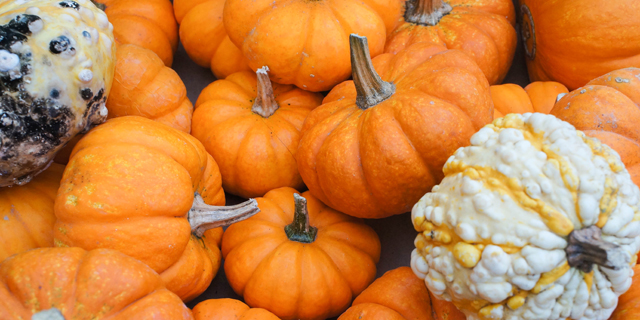Pumpkins have as long a history in our kitchens as they do in folklore and pop culture. The legends tell of witches turning people into pumpkins, but it’s pumpkins that are turned into people today through pumpkin carving in festivals, competitions, or simply to display on doorsteps for Halloween. Pumpkins aren’t just for show though, they’re for eating too and for good reason.
Pumpkin is rich in vitamins, minerals, fiber, and antioxidants including Vitamins A, C, E and K, and is bursting with potassium, magnesium, and iron too! Pepitas, pumpkin seeds, are also full of fiber making them a perfect snack. Clocking in at less than 50 calories per cup, it’s easy to see why pumpkin should be a year round staple, not just a fall indulgence.
How do I pick the best pumpkin?
Pumpkin picking is a big part of fall fun, but you have to do it right. Your pumpkin should be completely orange, on the small side, and heavy for it’s size. Small pumpkins are best for eating, while medium and larger pumpkins are great for carving. A ripe pumpkin has a hard shell and will be free of soft spots, cuts, or scratches. Steer clear from a pumpkin with cracks or splits which may indicate bugs, mold, or both.
What can I make with pumpkin?
Of course you can make pumpkin puree, great for baking in cakes, brownies, pancakes, scones, breads, and crisps. Put a spoonful in your oatmeal and enjoy the flavors of fall every morning! You can bake, roast, and broil pumpkin: add roasted pumpkin chunks to a quinoa salad or combine baked pumpkin with risotto topped with chorizo meatballs. Pumpkin works with both sweet and savory so how you use it is up to you!
The best way to prepare a small pumpkin is to poke it with a knife three times on the top and bake at 350F for an hour or two. Allow to cool, remove seeds, and proceed as your recipe directs or chef’s heart dictates.
And storage? Whole pumpkins will keep fresh in a cool, dark place for up to six months. Lay pumpkins on dish towels, cardboard, or newspaper and check them every week for soft spots. Cooked pumpkin will stay fresh in the refrigerator for five days. However, a raw pumpkin that has been cut into will only last a few days in the refrigerator. Cook or freeze that pumpkin as soon as possible. To freeze, bake pumpkin and remove seeds. Puree pumpkin, transfer to a plastic bag, and freeze. When ready to use, thaw in refrigerator. Stock up and you can have fresh pumpkin puree all year long!
Recipes to try include: Caramelized Pumpkin Soup, Pumpkin Spice Pancakes, and Pumpkin Churro Bites.


![Making Mealtime Matter with La Familia: Easy Sofrito [Video]](https://thelatinkitchen.com/wp-content/uploads/2015/10/sofrito-shutterstock__0-500x383.jpg)
![Easy Latin Smoothies: Goji Berry Smoothie [Video]](https://thelatinkitchen.com/wp-content/uploads/2015/12/goji_berry-shutterstock_-500x383.jpg)
















![Fun and Fast Recipes: Fiesta Cabbage Salad [Video]](https://thelatinkitchen.com/wp-content/uploads/2015/11/fiesta_cabbage_slaw-shutterstock_-500x383.jpg)









